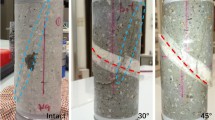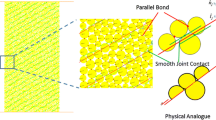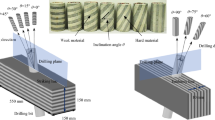Abstract
An instrumented section of a 10-m-diameter circular shaft located at a depth of 1.2 km in an average quality rock mass was back analyzed to establish the rock mass behavior. Extensometers were installed radially at four locations and provided the primary data for the back analyses. Three- and two-dimensional continuum models were analyzed using the numerical codes FLAC3Dand Phase2 to assess the rock mass behavior. An initial set of mechanical parameters obtained from empirical relationships were found to give a reasonable match to the measured response of extensometers 2 and 4, when using a Mohr–Coulomb strain softening model. A different set of parameters were needed for FLAC3D when trying to match the significantly higher displacements recorded by only one of the extensometer. It was noted that regardless of the material model and corresponding parameters, the three-dimensional models were not able to give reasonable match to the results of all extensometers. It was shown that for the given problem, there is a theoretical limit for ratio of displacements predicted for different extensometers using a continuum isotropic material model. The two-dimensional models in Phase2, however, gave an apparently better overall match to all the extensometers. Comparison of the results of three-dimensional models with the assumed longitudinal displacement profile for the two-dimensional model indicated that the three-dimensional effects were not adequately captured in the two-dimensional model.










Similar content being viewed by others
References
Cai M, Kaiser PK, Tasaka Y, Minami M (2007) Determination of residual strength parameters of jointed rock masses using the GSI system. Int J Rock Mech Min Sci 44:247–265
Carranza-Torres C, Fairhurst C (2000) Application of the convergence–confinement method of tunnel design to rock masses that satisfy the Hoek-Brown failure criterion. Tunn Undergr Space Technol 15:187–213
Cividini A, Jurina L, Gioda G (1981) Some aspects of characterization problems in geomechanics. Int J Rock Mech Min Sci 18:487–503
Gioda G, Maier G (1980) Direct search solution of an inverse problem in elastoplasticity: identification of cohesion, friction angle and in situ stress by pressure tunnel tests. Int J Numer Meth Eng 15:1823–1848
Hoek E, Brown ET (1980) Underground excavations in rock. Inst Min Metall, London
Hoek E, Brown ET (1997) Practical estimates or rock mass strength. Int J Rock Mech Min Sci 34:1165–1186
Hoek E, Carranza-Torres C, Corkum B (2002) Hoek-Brown failure criterion—2002 edition. Proceedings of the fifth North American rock mechanics symposium, Toronto, pp 267–273
Hoek E, Carranza-Torres C, Diederichs, Corkum B (2008) Integration of geotechnical and structural design in tunnelling—2008 Kersten Lecture. Proceedings University of Minnesota 56th Annual Geotechnical Engineering Conference, Minneapolis, pp 1–53
Hoek E, Diederichs MS (2006) Empirical estimation of rock mass modulus. Int J Rock Mech Min Sci 43:203–215
Itasca Inc. (2009) FLAC-fast Lagrangian analysis of Continua, Version 3.3, Minneapolis, United States
Miranda T, Dias D, Eclaircy-Caudron S, Gomes Correia A, Costa L (2011) Back analysis of geomechanical parameters by optimisation of a 3D model of an underground structure. Tunn Undergr Space Technol 26:659–673
Panet M (1995) Le calcul des tunnels par la me´thode convergenceconfinement. Presses de l’Ecole Nationale des Ponts et Chausse´es, Paris, p 177
Rocscience Inc. (2010) 3D tunnel simulation using the core replacement technique. Phase2 Version7.0 Tutorial Manual, Toronto, Canada
Rocscience Inc. (2011) Phase2—finite element analysis for excavations and slopes, Version 8.0, Toronto, Canada
Sakurai S, Takeuchi K (1983) Back analysis of measured displacements of tunnels. Rock Mech Rock Eng 16:173–180
Unlu T, Gercek H (2003) Effect of Poisson’s ratio on the normalized radial displacements occurring around the face of a circular tunnel. Tunn Undergr Space Technol 18:547–553
Vardakos SS, Gutierrez MS, Barton NR (2007) Back-analysis of Shimizu Tunnel No. 3 by distinct element modeling. Tunn Undergr Space Technol 22:401–413
Vlachopoulos N, Diederichs MS (2009) Improved longitudinal displacement profiles for convergence-confinement analysis of deep tunnels. Rock Mech Rock Eng 42:131–146
Yazdani M, Sharifzadeh M, Kamrani K, Ghorbani M (2012) Displacement-based numerical back analysis for estimation of rock mass parameters in Siah Bisheh powerhouse cavern using continuum and discontinuum approach. Tunn Undergr Space Technol 28:41–48
Acknowledgments
This work was financially supported by Natural Sciences and Engineering Research Council of Canada (NSERC).
Author information
Authors and Affiliations
Corresponding author
Rights and permissions
About this article
Cite this article
Rafiei Renani, H., Martin, C.D. & Hudson, R. Back Analysis of Rock Mass Displacements Around a Deep Shaft Using Two- and Three-Dimensional Continuum Modeling. Rock Mech Rock Eng 49, 1313–1327 (2016). https://doi.org/10.1007/s00603-015-0831-x
Received:
Accepted:
Published:
Issue Date:
DOI: https://doi.org/10.1007/s00603-015-0831-x




